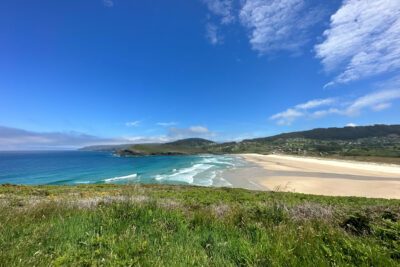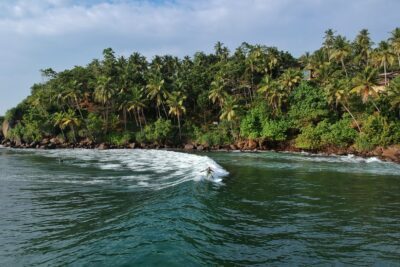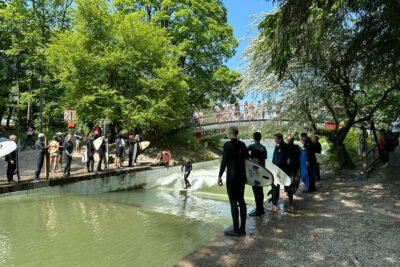Lisbon
Portugal’s capital and surf region Lisbon is worth visiting for a dozen reasons, and in addition, offers good surf. Nic von Rupp impressively showcases “Lisbon Surf City” in his youtube series Portugal Back to Back, which leaves no open questions. Watch the two videos below. Highlight surf spots in this area are, Carcavelos (surf competitions are held here), multiple breaks in Estoril, Praia do Guincho, Praia Grande and Praia das Maçás
Ericeira
The surf region Ericeira is Portugal’s and arguably Europe’s epicenter of surfing. Declared as the one and only World Surfing Reserve in Europe due to a high density of world-class waves within a short stretch of coastline and host to WSL competitions at Ribeira D’Ilhas, this place has been striving in popularity over the past years. High-Level surf spots popular among experienced and professional surfers are Cave, Coxos, and São Lourenço. Praia do Sul aka Praia da Baleia, Foz do Lizandro, and São Julião, on the other hand, are surf spots suitable for less experienced surfers and in between you will find a lot more spots in Ericeira, suitable to all levels of surfers, depending on the conditions.
Costa de Prata / Silver Coast
This part of the coastline of Portugal begins just north of Ericeira all the way up until the south of Porto. It includes the popular surf regions Peniche, Nazaré, and Figuera da Foz.
Peniche – Praia dos Supertubos
The most famous spot in the surf-region Peniche is Supertubos (“Super Tubes”), where during winter swells a fast and hollow barrelling wave breaks over sandbars, notorious for breaking boards. A surf spot for the advanced and professionals and for that reason at Supertubos, surf competitions like the WSL Rip Curl Meo Pro take place every year.
Peniche – Baleal & Ferrel
Besides Supertubos, which lies at a beach south of the city center of Peniche, you find the Peninsula Baleal and Ferrel. A great area for beginner and intermediate surfers with various long stretches of sandy beaches that face different directions and for that reason the area offers quite consistent surf.
Praia Baleal Sul (Baleal South Beach) is a big beach with various breaks depending on the conditions. On the other side at Praia Baleal Norte (Baleal North Beach), you find the surf spots Prainha, Lagide and Gigi. If none of those spots are working, your best shot might be a little bit further up the coast at Almagreira or Pico da Mota.
Nazaré
Just about a 45-minute drive north of Peniche lies the coastal fisher village of Nazaré with the largest submarine canyon in Europe, reaching depths of about 5,000 meters and a length of about 230 kilometers, producing exceptionally big waves during autumn and winter time. After the American professional big wave surfer Garrett MacNamara was invited to Nazaré in 2011 to “ride the world’s biggest wave”, Nazaré, the biggest and most monstrous wave-producing surf spot in the world took center stage in the surfing big wave community. Since then, the North Beach Praia Do Norte Nazaré – best viewed from the world-renowned lighthouse high up on the cliff in front of the canyon – has established itself as a household name, a major coastal tourist destination in Portugal, a (former) stop on the World Surf League’s “Large Wave World Tour”, and the place where big wave tow-in surfing (towing a surfer into a wave with a jetski) is most-commonly practiced.
Surfing Praia do Norte during smaller swells can be an option but still, the waves break unpredictably, fast, hollow and strong, and should only be approached by experienced surfers. On the other side of the lighthouse, you find Praia da Nazaré, the southern beach right in front of the town. This might be a better option if it is working and the shore break is not too intense. If you are in Nazaré during the autumn/winter season and besides watching want to surf yourself without putting your health or even life at risk, it might be a good idea to head down south to Peniche, or further north to Praia das Paredes.
Figueira da Foz
Figueira da Foz has a wide variety of uncrowded surf spots to choose from within short distance and golden sandy beaches. The two most well-known surf spots are Cabedelo – a beach break that works well on all states of the tide, plus in the right corner Cabdelo Point Break a wave that can break very nicely from the jetty – and Buarcos, considered Europe’s longest right-hand point break This long (up to several 100 meters) high-quality right-hand point break is mostly more of a carving wave, but there are some steep tubular sections. In the bay of Figueira da Foz, there are at least 3 point breaks (including Pico Da Mina and Cabo Mondego) that can connect with the right swell and form a very long wave which when it happens (most-likely with winter swells) makes Buarcos considerably the longest right-hand point break wave in Europe.
Aveiro
Heading further north from Figueira Da Foz, within about an hour’s drive, you will arrive at Aveiro, a beautiful coastal city in Portugal known for its picturesque canals, colorful gondola boats, and stunning beaches. Aveiro’s charm and unique atmosphere make it an enjoyable place to combine surfing with cultural experiences and exploration of the region. Surf Spots in this area include Praia da Vagueira, Praia da Barra, Sao Jacinto.
Costa Verde / Green Coast
Porto
Costa Verde is Portugal’s most northern region, associated with the country’s second-largest city, Porto. Situated north of the Costa de Prata this region reaches all the way up to the Spanish border and its region of Galicia. Surfing in this region may take place in a generally colder climate including colder waters. Notable spots include Aguçadoura, Cabeldo Beach near Viana do Castelo, Azurara near Vila do Conde, Espinho (already adjacent Aveiro region), and Matosinhos (accessible via Porto’s metro public transport).
Madeira
An autonomous Region of Portugal is the island of Madeira, situated about 950 kilometers southwest of Portugal’s mainland. The surf region Madeira consists of two populated islands: the main island of Madeira and Porto Santo, while most of the surfing takes place on the main island. Notable surf spots in Madeira are the advanced-level surf spots Jardim do Mar which can get turn into a firing big wave surfing spot during winter swells, Paul do Mar (known for its barreling wave), Lugar de Baixo, and Ponta Pequena. For less experienced surfers São Vicente is a good spot, situated on the north coast.
Azores
The Azores is another autonomous Region that consists of 9 islands, about 1,400 kilometers west of Portugal’s mainland coast. One of the best areas within the surf region Azores is the island of Terceira, which hosts a good amount of surf spots on its north shore, from northeast to northwest. The northeast coast of the island São Miguel features some of the most well-known surf spots on the Azores that are consistent, powerful, and uncrowded: Ribeira Grande and Rabo de Peixe. Beware as waves can get big and dangerous, especially during winter swells.
3. Surf Season in Portugal – The Best Time to Surfing Portugal
Portugal offers surfing all year round. As in most parts of the world, during the summer months the surf is smaller and less consistent (more flat days), while during the winter months, the swell gets bigger. The biggest and most consistent swells arrive at the Atlantic coastline of Portugal between September to April, making it the perfect time for experienced surfers to catch good waves. It also is the time when professional surfers come surfing Portugal to compete at WSL World Tour events, for example in Ericeira and Peniche. Beginner or lower intermediate-level surfers on the contrary are better off visiting Portugal during the summer months or during autumn/winter surf in the most southern regions of the country (Algarve and Alentejo), rather than up north.
5. What to do in Portugal besides Surfing?
When the days are flat, there are plenty of things to do in Portugal across all regions. Our favorites by far are the two biggest cities Porto and Lisbon which both offer plenty of things to do.
Visit Lisbon
From the Algarve / Alentejo or Ericeira area, Lisbon, the capital of Portugal is not far and always worth a visit. The city offers plenty of shopping opportunities, cultural activities, and amazing food places.
Visit Porto
If you are headed more to the northern part of the county, you must visit Porto. For example, from Nazaré it is only a two hours drive. The mix of medieval, modern glamorous, and industrial shabby is very unique and absolutely blew our minds. Cool city, with a great vibe, lovely people, and great food + port wine, and all the places are very well connected within short distance.
The bus and metro system is working great to get around the city and even from Porto’s center, just hop into the metro and head to Matosinhos (about 40 minute drive) from where you can walk to the surf. Besides, Matosinhos is a striving area with a lot of cool restaurants, shops, and art venues. In addition, if you want to surf another break, you can also take the train direction south to Espinho.
Visit Sintra
Sintra is located 30 kilometers to the west of Lisbon, in the center of Portugal. Home to ancient castles, extravagant palaces, and beautiful natural scenery, Sintra is a perfect day trip getaway from Ericeira or Lisbon.




